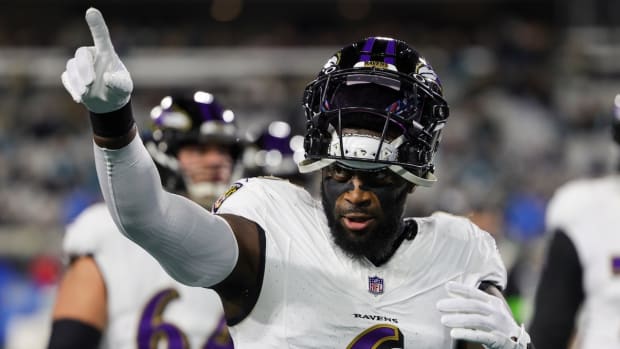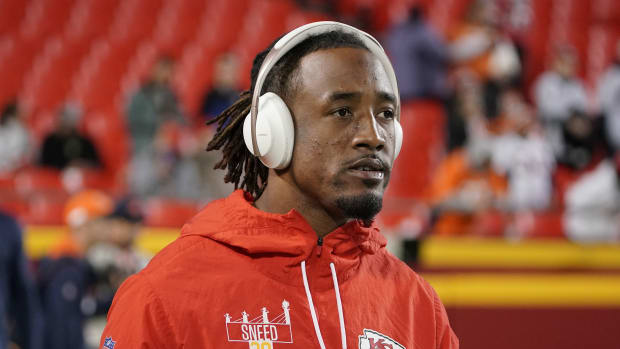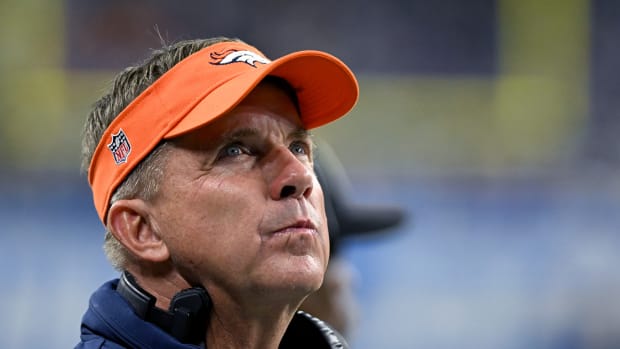How the Seahawks Built a Run-Based Offense That Better Suits Russell Wilson
Last year Russell Wilson was the NFL’s darling. Running around making sandlot plays that looked spectacular on TV, he achieved an enviable impermeability to criticism. He was constantly lauded for bucking quarterbacking norms, and if you spoke up about the downside of his sandlot approach—throws left on the field, the burden that unstructured quarterbacking could put on Seattle’s offensive line and receivers, the inherent snap-to-snap inconsistency you get when plays are not executed as designed—you were deemed either a moron or hater.
By December, Wilson was miles above reproach, so when he was held to under 110 net yards passing a game in Seattle’s 1–2 finish to miss the playoffs last year, few seemed to notice—but the Seahawks brass did. It wasn’t just the defense that head coach Pete Carroll and GM John Schneider overhauled after the season; they also fired offensive coordinator, Darrell Bevell.
On the surface this looked like validation for Wilson. The star quarterback hadn’t limited Seattle’s offense—the play-caller had. But then the Seahawks filled their vacant offensive coordinator post with Brian Schottenheimer, a proven ball-control designer whose father famously played “Marty Ball”—old-school, run-first offense.
NFL POWER RANKINGS: Chargers Make Their Case for the Top Spot
After starting 0–2 this season, during which Wilson dropped back 69 times, the younger Schottenheimer fully instilled his father’s approach, running the ball on a league-high 58% of snaps since. Many of those runs have come behind six offensive linemen, with backup tackle George Fant serving as the “tight end.” Fant’s workload has risen steadily to the point where he now plays more than one-third of the snaps.
Seattle’s ground game has also been more schematically diverse. Fired along with Bevell was offensive line coach Tom Cable and his strict outside zone running game. Hired with Schottenheimer was 63-year-old O-line coach Mike Solari, who has helped install a bevy of man-to-man run-blocking designs, misdirectional jets sweeps and traditional inside zone runs, with double-team blocks at the point of attack.
The Seahawks’ offense no longer goes through Russell Wilson. He is a complementary piece in a smashmouth system, which makes the best use of his unique gifts. This was the approach the Seahawks took in the Marshawn Lynch heyday, when they went to back-to-back Super Bowls.
A run-first offense does several things that best suit Wilson:
• It puts defenses in more predictable looks. With predictable looks, it’s easier for an offense to execute deep-shot plays, especially from play-action. Those deep shots highlight Wilson’s downfield touch passing, which is amongst the best in the league.
• It builds the threat of Wilson’s legs into more of the designs. You get more rhythmic use of the read-option, where Wilson is conservative but greatly feared. You integrate your running concepts into your passing game. Instead of hoping that Wilson gets out of the pocket and makes magic, you can design plays that put him on the move more naturally. This has a double-dip benefit, as eventually backside defenders become so worried about Wilson on designed movement that they’re hesitant to attack runs on the front side. Seattle’s ground game builds parts of the passing game, which, with Wilson, makes that ground game even stronger.
• It gives the Seahawks a rhythm. Under Bevell they were often a snap-to-snap offense, with each play feeling like an individual entity. In a run-first approach, more plays build off each other, offensive linemen start knowing what to expect, and Seattle controls the game’s flow.
NFL Coaching Hot Seat: Steve Wilks, Doug Marrone Are Feeling the Pressure After Week 15
Wilson, in turn, has become a better quarterback than he was in 2017. His sandlot playmaking will always have a place and is actually more potent now, coming within the context of a more defined offense. And Wilson, no longer feeling he must carry the offense, has become a calmer pocket player. He’ll always leave some throws on the field because, at 5' 11", there will be throws he simply can’t see. But those have been fewer and farther between as Wilson has become more willing to operate from within the pocket. Some of his best throws in 2018 have come when he extends red-zone plays at the top of his dropback and trusts that the defense will break down before the play itself does.
Unfortunately, disciplined quarterbacking can look almost monotonous to television viewers. And so this year the NFL’s darling is the man Wilson faces Sunday night—Kansas City’s Patrick Mahomes. The second-year Chief actually is what people last year misguidedly thought Wilson was: a quarterback who can carry an offense week in and week out. Mahomes’s electrifying sandlot plays rarely come at the expense of Kansas City’s rhythm. The first-year starter’s instinct is to play on-schedule and trust the designs. It helps that those designs are, frankly, much better than the ones Wilson played under last year. Andy Reid’s offense is a medley of deception and aggression, and Tyreek Hill and Travis Kelce are first-class superstar receivers—something Wilson has never had. Also, it’s entirely possible that Andy Reid trusts Mahomes more than Bevell ever trusted Wilson.
Those who have beaten Mahomes have done so in shootouts: Tom Brady and the Patriots; Jared Goff and the Rams; Philip Rivers and the Chargers. We’ll learn Sunday whether the Chiefs can be bested by a ball-controlling offense that (hopefully) keeps Mahomes off the field. Kansas City has a predictable and maddeningly inconsistent run defense; Seattle has the NFL’s most expansive ground game…plus a quality quarterback who is now being asked to complement it.
TWEET ELABORATION
With today’s emphasis on run-after-catch and wide receiver screens, not to mention running backs’ tendency to bounce, cornerback tackling is often the difference between gains being small and large. The best defenses usually have corners who can tackle.
THE NEXT GREAT RIVALRY
Last Sunday’s Patriots-Steelers game offered a glimpse into the future, where a fantastic individual rivalry awaits: Steelers receiver JuJu Smith-Schuster against Patriots corner J.C. Jackson. Smith-Schuster is gradually infringing upon the still-great Antonio Brown’s turf. Ben Roethlisberger trusts the second-year receiver’s contested-catch ability enough to target him when covered. More telling is that Smith-Schuster has gotten meaningful snaps on the weak side of the formation, where Brown has spent most of his career. (Among other benefits, putting your best receiver on the weak side clearly defines the coverage when a defense doubles him.)
For long-term star potential, Jackson is less of a sure-thing than Smith-Schuster but equally as intriguing. Cornerback is the most athletically demanding position in football, which is why you so rarely see undrafted ones on the field. For an undrafted rookie to penetrate the starting lineup on a stalwart veteran team like New England is remarkable. Jackson has what every defense needs: a sense for stymieing downfield patters. With long arms plus a thick and broad-shouldered frame, he is already one of the game’s best vertical route defenders. He traveled almost everywhere with Smith-Schuster on Sunday and held the young star to 40 yards on four catches.
BASKIN: Patriots Don’t Look Like Themselves in Loss to the Steelers
A BLUEPRINT ON THE RAMS
It’s out there. The Rams offense has been uncharacteristically choppy these last three games—losses to the Eagles and Bears, and an ugly win at Detroit. Those three defenses all featured two-deep matchup zone coverages and, in the cases of Chicago and Philly, a potent pass rush. L.A.’s vertical designs haven’t worked as well against the two-deep matchup zones, and this well-schooled Rams O-line has lost too many individual battles. That’s a concern heading into the playoffs given the formidability of D-lines like Chicago’s, Dallas’s, New Orleans’s, Minnesota’s and even Seattle’s.
A STAR IN INDY
Seattle’s OC Brian Schottenheimer and O-line coach Mike Solari, for the reasons covered above, deserve consideration for Assistant Coach of the Year, but right now the front runner is Colts first-year defensive coordinator Matt Eberflus. Installing a Rod Marinelli-style zone scheme with a bevy of young players and veterans who were cast for Chuck Pagano’s very different Ravens-style scheme, Eberflus, in the back of his mind, probably figured he was a few years away from having a quality unit. And, in some ways, he might be, as the Colts, with loads of cap space this offseason, figure to still spend on pass rushers and defensive depth. But in the meantime, their young players have looked sharper by the week. Last week against Dallas, their zone scheme accelerated the subtle expansion it had lately been showing, as the Colts confounded Dak Prescott with a slew of fire zone blitzes. A win over the Giants next week would put the Colts and this defense in strong position for perhaps the unlikeliest playoff appearance of 2018.
DO YOURSELF A FAVOR
This time of year, I listen to holiday music during the majority of my waking hours, as it plays softly in the background when I watch film. One song that I’ve always found to be exceptionally “just okay”—like the Kit Kat bar of Christmas songs—is Last Christmas by Wham!. But then I stumbled across the music video. At first I scoffed; it’s the most 1980s-cliched visual art ever created. But I was surprised, and eventually charmed, to discover that the video strictly portrays the story of the song. There are no cutaways of the musicians performing someplace weird (like on a mountaintop or in blank white room or something) and, with it being the 80s, there’s none of the ridiculous group dancing and flashing lights that ruin most videos today.
Instead, viewers see Wham! lead singer George Michael and his friends on a mixed couples ski trip, where both Michael’s current girlfriend (the “someone special” to whom he gave his heart this year) and former girlfriend (who last Christmas gave his heart away “the very next day”) are in attendance. For much of the video, Michael and Last Year’s Girl engage in a riveting dance of passive aggressive flirtation. The only people who seem to know there’s drama are those involved—Michael and Last Year Girl—and, of course, the viewer. It is a masterful portrayal of the petty, everyday fight for small power that, deep down, we all live for. Every Christmas music aficionado needs to enjoy this video.
Question or comment? Email us at talkback@themmqb.com.




































